
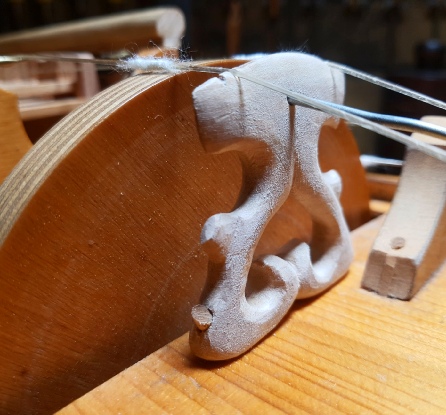
A mechanized medieval violin?
A mysterious strange thing is it...
It looks like a guitar with piano keys, but to get sound out of it you have to turn a crank - lyre...
It doesn't work on air, isn't an organ,
and even works a bit magically...
The sound of this musical instrument is somewhat reminiscent of a bagpipe or shawm, but with a violin-like tone.
It looks like a guitar with piano keys, but to get sound out of it you have to turn a crank - lyre...
It doesn't work on air, isn't an organ,
and even works a bit magically...
The sound of this musical instrument is somewhat reminiscent of a bagpipe or shawm, but with a violin-like tone.
"Hurdy-gurdy" or "violin wheel"...
In several countries it is called “Hurdy gurdy”
In French: Vielle à roue
In German: Drehleier of Radleier
Spanish, Zanfona
English: Hurdy-gurdy
Danish: Drejlire
Italian: Ghironda
Polish: Lira korbowa
Slovenian: Nira
Swedish; Gurdy
Icelandic: hraðaskúr
Finnish: Hurdy-Gurdy
Japanese: Hādigādi
Turkish; Hurdy-gurdy
Perzian: Gardi
Arabic: Alt alhardi jurdi
Nepali: Harḍī-garḍī
Russian: Sharmanka
Filipino: Hurdy-Gurdy
There is always something to tell and learn about hurdy-gurdies…
The hurdy-gurdy's predecessor is an organistrum,
just as a fiddle is the predecessor of the modern violin...
And the nyckelharpa's predecessor is the moraharpa...
In several countries it is called “Hurdy gurdy”
In French: Vielle à roue
In German: Drehleier of Radleier
Spanish, Zanfona
English: Hurdy-gurdy
Danish: Drejlire
Italian: Ghironda
Polish: Lira korbowa
Slovenian: Nira
Swedish; Gurdy
Icelandic: hraðaskúr
Finnish: Hurdy-Gurdy
Japanese: Hādigādi
Turkish; Hurdy-gurdy
Perzian: Gardi
Arabic: Alt alhardi jurdi
Nepali: Harḍī-garḍī
Russian: Sharmanka
Filipino: Hurdy-Gurdy
There is always something to tell and learn about hurdy-gurdies…
The hurdy-gurdy's predecessor is an organistrum,
just as a fiddle is the predecessor of the modern violin...
And the nyckelharpa's predecessor is the moraharpa...

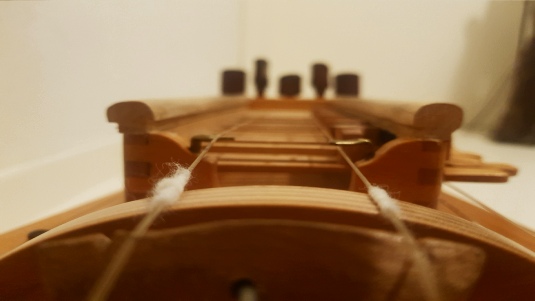
Tangents

Drone & Melody string

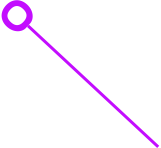
Discard pins for strings


Pegs

Melody
Drone(BAS)
Drone (Trompet)
Drone


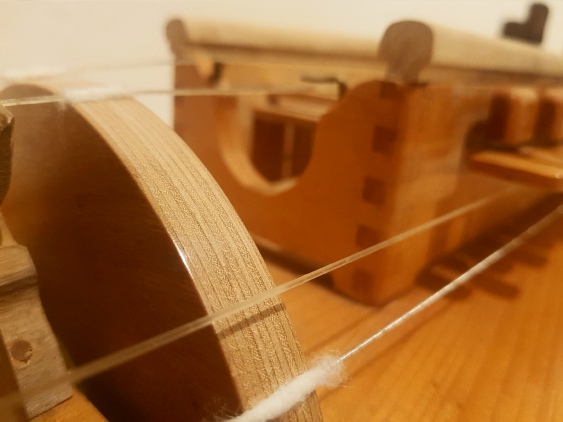
Wooden slide keys
without tangents
without tangents
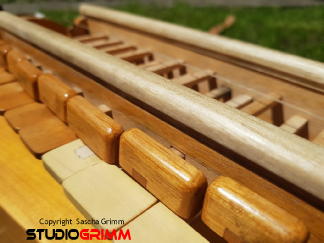



Tangents


Upper Keys - semi notes
(slide keys)
(slide keys)

This hurdy-gurdy originally had two melody strings and double tangents.
The tangents were too long, so they often snapped. Tangents made of other types of wood, including those of different lengths, are regularly tested.
The tangents were too long, so they often snapped. Tangents made of other types of wood, including those of different lengths, are regularly tested.
Bridge

The hurdy-gurdy spread throughout Europe during the time of the Crusades.
Many new shapes and models emerged over the centuries...
Around the 14th century, the Moraharpa emerged from this in the far north.
This instrument, which also looks bizarre, resembles a hurdy-gurdy, but instead
of being wheel-driven, a short bow is used instead of a wooden wheel.
The wooden sliding keys with tangents remained. It was only during the Renaissance that the Moraharpa evolved into a nyckelharpa, when the semitones and sympathetic strings were added.
These days, the hurdy-gurdy is making a bit of a comeback, though more so in modernized models with
electric amplification and modern tuning pegs, etc., where the sound box and
special wood type no longer play a significant role.
The sound is absolutely incomparable to the classic acoustic hurdy-gurdy.
A modern hurdy-gurdy sounds like an electric guitar, even without the need for a sound box.
Fully digital models also exist, without strings, though the authentic sound and tone are lost.
They are, however, fun models for practicing completely undisturbed at night with headphones on.
With the classic acoustic hurdy-gurdy models, the sound reverberates beautifully...
Playing with the drone string in the background creates that one magical, strange effect: a soft, steady bass hum sounds in the background, similar to a bagpipe.
The vibration of a bass drone can be felt up close and personal, and for some, it has a meditative and calming effect.
Experiencing a hurdy-gurdy live up close is different from seeing it in photos or videos.
Live up close is a different experience…
It sounds much less loud than bagpipes, and there are also various ways to play it.
Bridge
for melody string
for melody string
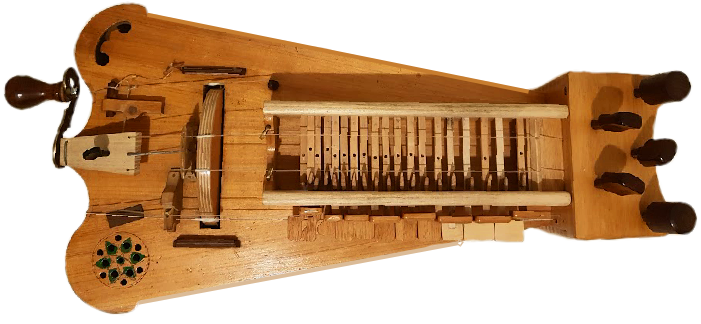
Wheel


Tangent box
Tuning pegs


pegs
Tailpiece


Semi notes
(Slide keys)
(Slide keys)
Diatonic keys
(slide keys)
(slide keys)

Wheel cover
Wheel cover

Knob or handle



Drone string

Melody string

Drone string (BASS)

Tangents
(wooden flags)
(wooden flags)
Bridge for
drone string
drone string

Rosette
(Soundhole)
(Soundhole)
Rosette
(Soundhole)
(Soundhole)

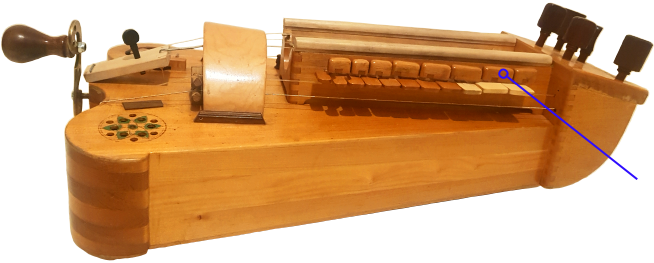
Semi notes, black keys
Tangent box
Diatonic keys
Wheel cover
Tuning pegs

Wheel arch support

Hurdy gurdy explained...

Bridge
Wheel


Melody string with cotton

Wheel cover
Wheel support piece
Why do the strings in these areas on the wheel look so worn?
It might seem like the strings are almost worn out, but that's not the case.
The strings aren't worn out.
What you see is cotton wrapped around the strings.
The strings are wrapped with fine, clean, fluffy cotton to prevent wear from friction on the wheel.
It also produces a slightly finer sound.
The strings aren't worn out.
What you see is cotton wrapped around the strings.
The strings are wrapped with fine, clean, fluffy cotton to prevent wear from friction on the wheel.
It also produces a slightly finer sound.




Resin dissolved in alcohol
Resin ground into powder
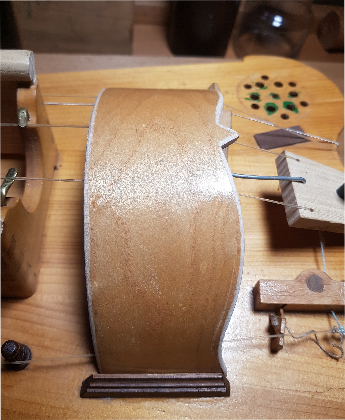
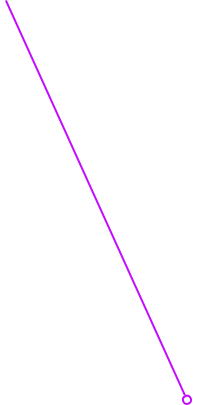
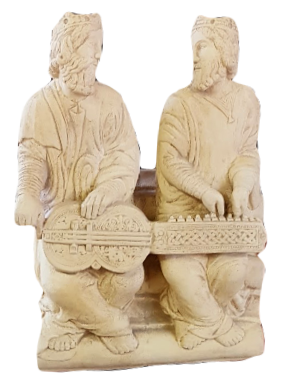


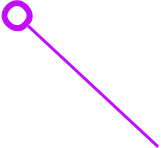

Cotton
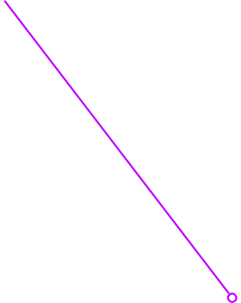
Cotton

Detached tangents (flags)
Wooden keys
tangent box
tangent box
Crank,winch
Tuning peg
Hard resin
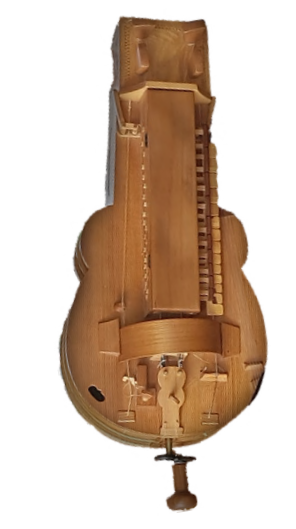



A natural, purified resin is applied to the wheel, making the surface slightly rough.
When a string touches the wheel, it bounces, creating a vibrating sound similar to that of a violin.
The wheel then works like a violin bow across the strings.
If you're looking for quality products for your hurdy-gurdy, such as liquid rosin, powdered rosin, rosin blocks, cotton strings, etc., and you can't find them anywhere or you're not sure, then order them here at Studio Grimm...
When a string touches the wheel, it bounces, creating a vibrating sound similar to that of a violin.
The wheel then works like a violin bow across the strings.
If you're looking for quality products for your hurdy-gurdy, such as liquid rosin, powdered rosin, rosin blocks, cotton strings, etc., and you can't find them anywhere or you're not sure, then order them here at Studio Grimm...
It is believed to have existed since the 10th or 11th century.
Ancient writings refer to "Hucbald" of St. Amand, a French monk who practiced organ there.
A unique statue can be found in the "Cathedral of Santiago de Compostela" (around 1188) "The Porch of Glory."
The large carving decoration features a statue of two kings playing an "organistrum."
It was a large instrument, so it required two people to play.
One turned a crank, and the other pulled the keys up instead of pushing them up as is done today.
There are no trumpet strings visible on it yet; they were added much later,
just like the sympathetic strings, which were only added around the 16th century.
In an old Spanish monastery founded in 1194, a 14th-century painting can be found depicting a hurdy-gurdy guitar.
The tangent box appears to be the neck of a guitar instead of frets.
The sound box is also distinctive and has six sound holes.
At the old "Cathedral of León," dating from the 13th to the 14th century, a hurdy-gurdy player can also be found in the stone carvings.
A hurdy-gurdy player with a rectangular box model.
Ancient writings refer to "Hucbald" of St. Amand, a French monk who practiced organ there.
A unique statue can be found in the "Cathedral of Santiago de Compostela" (around 1188) "The Porch of Glory."
The large carving decoration features a statue of two kings playing an "organistrum."
It was a large instrument, so it required two people to play.
One turned a crank, and the other pulled the keys up instead of pushing them up as is done today.
There are no trumpet strings visible on it yet; they were added much later,
just like the sympathetic strings, which were only added around the 16th century.
In an old Spanish monastery founded in 1194, a 14th-century painting can be found depicting a hurdy-gurdy guitar.
The tangent box appears to be the neck of a guitar instead of frets.
The sound box is also distinctive and has six sound holes.
At the old "Cathedral of León," dating from the 13th to the 14th century, a hurdy-gurdy player can also be found in the stone carvings.
A hurdy-gurdy player with a rectangular box model.



Hurdy - Gurdy (Explained)

Website in Flemish - Dutch
Click here
Click here
.png)